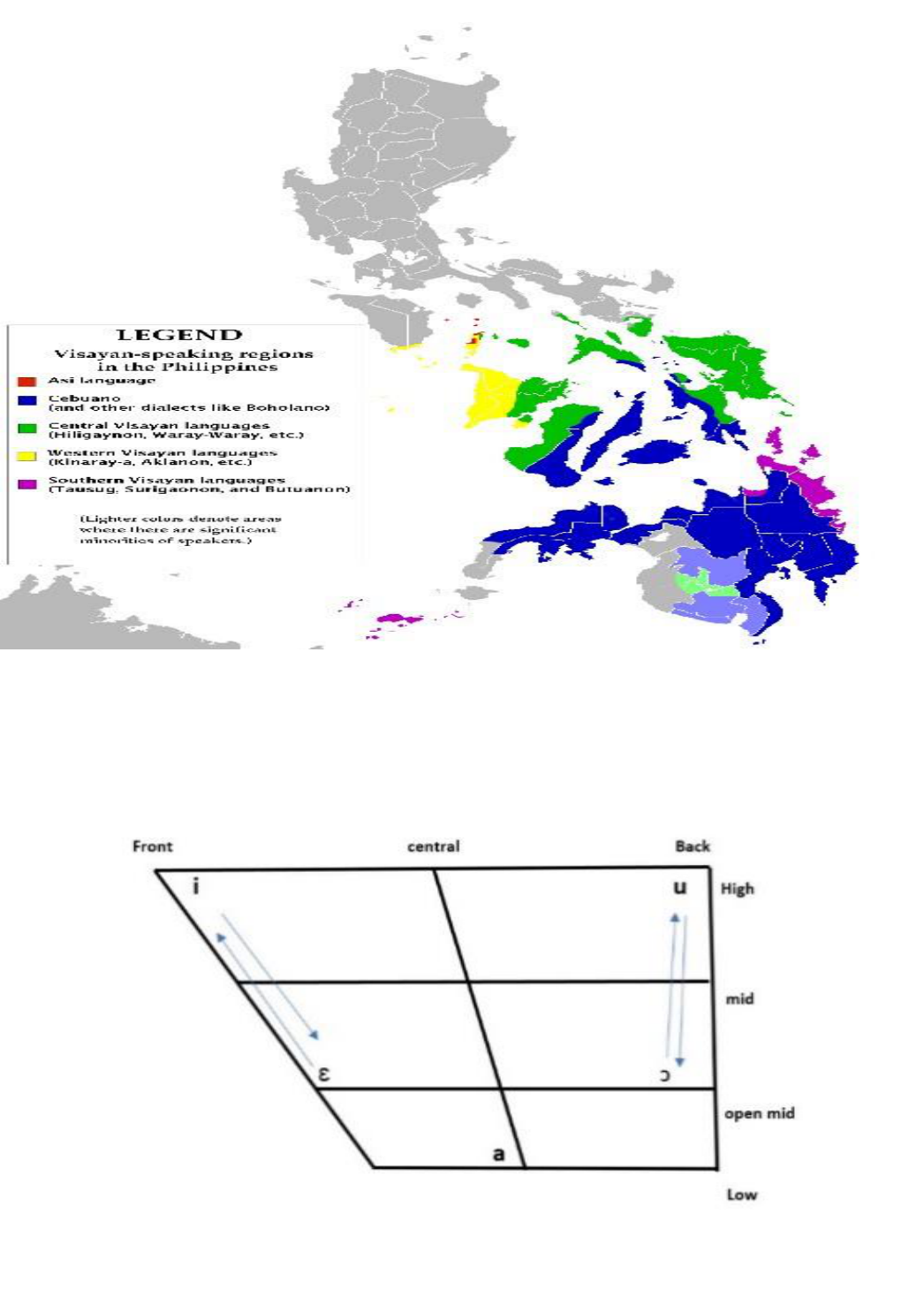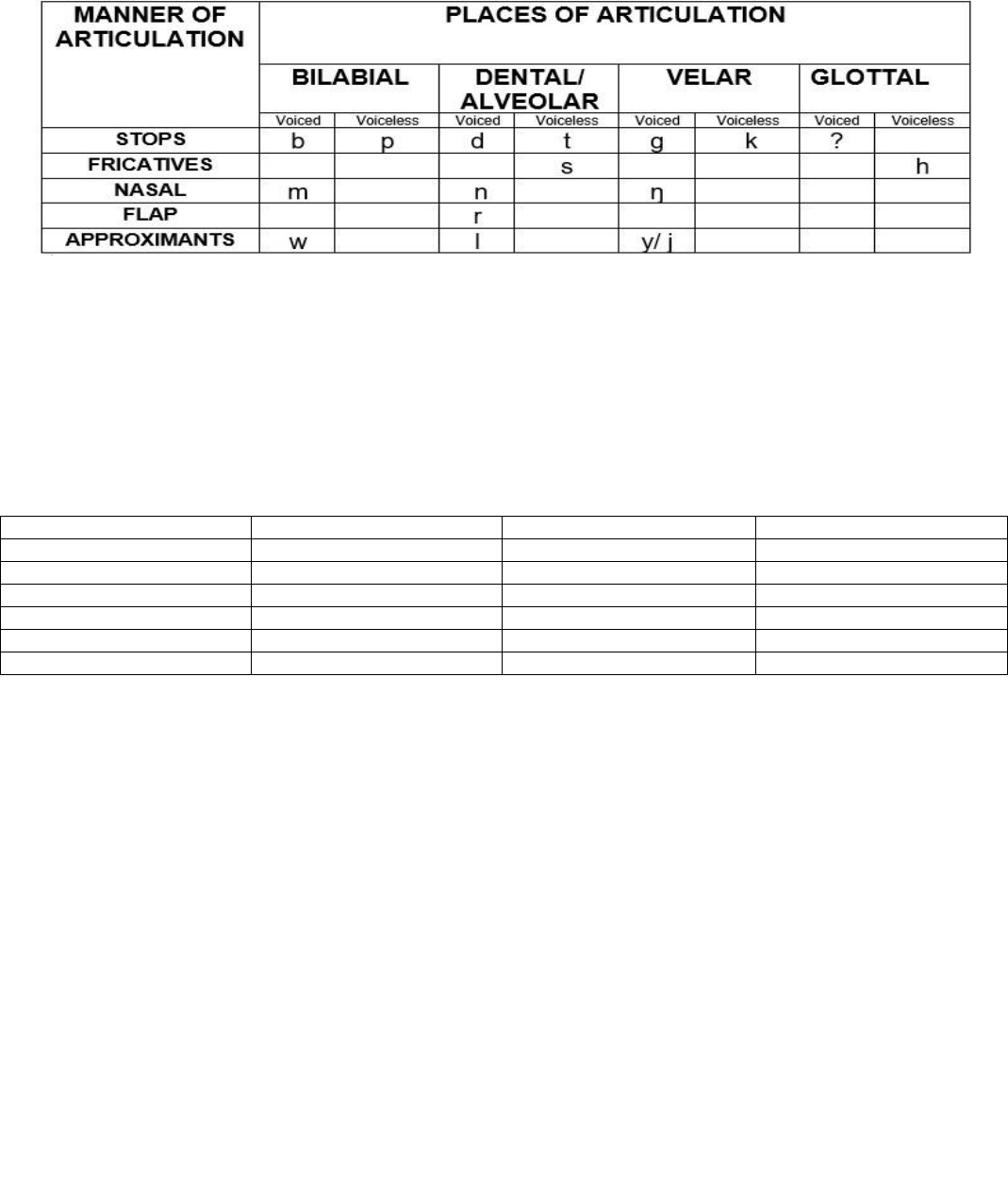
Volume 8, Issue 2, February – 2023 International Journal of Innovative Science and Research Technology
ISSN No:-2456-2165
IJISRT23FEB832 www.ijisrt.com 801
A Grammar of Bisaya in Davao
Mary Jane A. Cooke
University of Mindanao
Ana Helena R. Lovitos, PhD, MedStud
University of Mindanao
Abstract:- This research presents a detailed linguistic
description of the Bisaya in Davao language based on the
examination of Basic Linguistic Theory. Three primary
language consultants are native speakers of the language
who translated and recorded word and sentence lists for
accurate pronunciation. The analysis reveals the
language's phonological, morphological, syntactic, and
morphosyntactic characteristics. Based on the translated
eliciting materials spoken and pronounced by the
language consultants, there are three vowels and sixteen
consonants in the phonemic inventory. Distinct
phonological characteristics such as minimal pairs,
diphthongs, and phonotactics are readily apparent. It
demonstrates that the language has morphological
characteristics and follows ergative-absolutive and verb
Initial structure, precisely like other Austronesian
languages in the Philippines. This description provides
actual language documentation, additional research on
language contact or migration, linguistic typology, and
crosslinguistic study. This is vital for students and
teachers in DepEd Davao in teaching the Bisaya in
Davao as a mother tongue.
Keywords:- Applied Linguistics; Bisaya, Language
Description; Linguistic Features; Philippines.
I. INTRODUCTION
The Cebuano (ISO 639-3 ceb) language belongs to the
"Austronesian, Malayo-Polynesian, Greater Central
Philippine, Central Philippine, Bisayan, Cebuano,
Mansakan, Davaweño. It is extensively spoken in the Bicol
region, including parts of Mindanao and the Visayas
(Ethnologue, 2021). Although the Expanded Graded
Intergenerational Disruption Scale (EGIS) (Simons &
Fennig, 2022) considers the language to be institutional, that
is, it has been developed to the point and is used and
sustained by institutions beyond the home and community;
the language still needs to be documented to add to the
language's sustainable and functional literature.
In her study, Rubrico (2012) defined Cebuano,
referred to as Bisaya or Binisaya by the people of Davao, as
the language most people speak. In addition, she cited
Ethnologue (2009), one in every three (33.32%) is Cebuano.
The regional quarterly publication of the Davao NCSO
gives the following ethnolinguistic groups distribution in
Davao: Cebuano, 74.56%; Tagalog, 3.86%; Hiligaynon,
3.43%; Bagobo, Guiangao, 3.16%; Davaweño, 1.26%;
Tagacaolo, 2.38%; Bilaan, 1.67%; Ilocano, 1.01%; Waray,
0.55%; Manobo, 2.15%; Maguindanao, 1.91%; Mandaya,
2.01%; other languages, 2.04%; uncertain, 0.01%.5
According to Ethnologue 2009, Davawenyo synthesizes
Filipino, Cebuano, and other Visayan dialects. In addition,
Lobel and Pouezevara (2021) added that the only Philippine
language with a native speaker population that approaches
Tagalog (16 million) is Cebuano. Additionally, Cebuano,
which is spoken as a native tongue in the central part of the
Philippines, is the only language to match its geographic
range, the majority of central and eastern Mindanao, the
Visayan Islands, and beyond. Compared to Tagalog as the
most extensively studied language among the various
academic studies on the Philippine languages, as claimed by
Jubilado (2021), Davao Bisaya is scarce and limited as
studies were focused richly on the Visayas region.
Moreover, it appears to be undocumented throughout
Mindanao, particularly Davao City. Some literature
available on the linguistic analysis of Cebuano is rich and
timely. However, as a result, it is critical to preserve this
Davao variety. Hence, it the important to document this
Davao variety to add to the rich literature of Philippine
languages. Language is an ever-evolving entity it is difficult
to predict when it will change (Atos,2015). Therefore,
language documentation is an essential task for any linguist
and research enthusiast to consider. However, high-quality
data and literature availability are critical for continuing
these investigations. Speakers of all languages must
consciously document their languages so that future
generations can utilize them as guides or references.
The documentation of languages, cultures, and
histories of the world's peoples has been an exciting
undertaking in the past, as Hinton, Leanne, et al. (2018) put
it. She cited epi-Olmec hieroglyphic writing, one of the
many writing systems developed in Mesoamerica and used
thousands of years ago. Besides, the works of Campbell,
L.& Rogers, C. (2015) and (Klessa, 2014) made a brief
review of the history of linguistic ideas shows. It intensified
that language documentation is among the oldest traditions
in the linguistic field.
New literature, such as grammar, would be a great
addition. While it is true that this language is thriving and
valuable in some pillars of society, it is still undeniable that
it will be a rich addition to the teaching of the mother tongue
under DepEd's Mother Tongue-Based Multilingual
Education (MTBLE) to uphold its Four Minima for a
language to become a mother tongue: weaving to standard
orthography, grammar, dictionary, and literacy materials. In
this case, this study would address the grammar requisite.
Suffice it to say that this endeavor of the Grammar of Bisaya
in Davao is significant.
It is for this cause that this proposal is postulated.
Writing a Grammar involves two primary objectives:
documentation of threatened or endangered languages and

Volume 8, Issue 2, February – 2023 International Journal of Innovative Science and Research Technology
ISSN No:-2456-2165
IJISRT23FEB832 www.ijisrt.com 802
(making these languages mother tongues. Documentation
includes a detailed description of the language's
phonological, morphological, and syntactic aspects.
II. METHOD
The research design of this paper is qualitative
descriptive research, specifically descriptive which explores
the documentary analysis and involves gathering data
through comprehensive interviews from the selected three
informants who are Bisaya native speakers. The research
participants or language consultants were three Davao
Bisaya, native speakers in Davao City. Before data
collection started, I prepared the elicitation materials, which
are the 505 Wordlist and 700-sentence list from the
University of the Philippines Linguistics Department, within
the parameters of my research study. Experts validated the
elicitation materials to ensure the viability of the expected
output. The language consultants of this study were three
participants who were native speakers of the language. They
are more than 20 years old. They were educated enough to
translate from their native language to Bisaya and Tagalog.
Barlow (2020) noted that people older than 30 tended
to be fluent speakers (of varying proficiency). In contrast,
people in their twenties only seemed capable of producing
basic phrases (although their comprehension might have
been quite good). The translation was conducted in the
comfort of their preferred location during their free time.
For further clarification and validation of the elicited data,
these respondents were interviewed in person and via
Facebook messenger.
To gather sufficient data for this study, I used the
elicitation technique to collect the data for this study. I
utilized the elicitation materials, such as the 505-Word List
and the 775-Sentence List designed and enhanced by the
linguistics department of the University of the Philippines
(Diliman) (UP Department of Linguistics, 2018a, 2018b,
2018c). The elicitation materials were used with appropriate
consent from the rightful owner. The first three materials
enumerated above are all wordlists, which have been
utilized to collect lexical data from the Bisaya language to
decide how to test the emerging conclusions.
This study was conducted with a firm adherence to the
ethical protocols. The researcher religiously requested and
secured from key school officials the corresponding
permission necessary to complete this research.
Furthermore, the researcher ensured the appropriateness of
identified recruiting parties and reviewed the risks and
measures to mitigate these risks (including physical,
psychological, and social-economic. Proper authorization
and consent are also obtained from the sample of the study,
in which they are assured that all their rights would be fully
protected, specifically in handling the data such as, but not
limited to, voluntary participation, privacy, and
confidentiality, informed consent process, recruitment,
benefits, plagiarism, fabrication, falsification, conflict of
interest (COI, deceit, permission from organization/location:
Technology Issues and authorship.
III. RESULTS AND DISCUSSION
With roughly 16 million native speakers, Cebuano is
the only language spoken in the Philippines, close to
Tagalog's native speaker population. Moreover, speaking as
a native tongue in the central region of the Philippines,
Cebuano is the only language to match its geographic
breadth—the majority of central and eastern Mindanao, the
Visayan Islands, and beyond.
The Place where the Language is Spoken
Bisaya or Binisaya is a variety of the Cebuano (ISO
639-3 ceb) language. It belongs to the "Austronesian,
Malayo-Polynesian, Greater Central Philippine, Central
Philippine, Bisayan, Cebuano, Mansakan, Davaweño.
Widely spoken in the Bicol region: south Masbate province;
parts of Mindanao; throughout the Visayas regions
(Ethnologue, 2021). Cebuano is classified as ISO 639-3 ceb,
a member of the "Austronesian, Malayo-Polynesian, Greater
Central Philippine, Central Philippine, Bisayan, Cebuano,
Mansakan, and Davaweño" ethnic groups. The Philippine
language is widely spoken in the Bicol region, including
south Masbate province, sections of Mindanao, and the
Visayas. It is natively called by its generic term Bisaya or
Binisaya.

Volume 8, Issue 2, February – 2023 International Journal of Innovative Science and Research Technology
ISSN No:-2456-2165
IJISRT23FEB832 www.ijisrt.com 803
Fig 1 Visayan Language Distribution Map
Source: Https://Commons.Wikimedia.Org
Bisaya in Davao Phonological Component
The Bisaya's phonological structure in Davao comprises the phonemic inventory of vowels and consonants, phonotactics,
which addresses the restrictions on phoneme combination, and phonological constraints, which address Bisaya in Davao
consonant clusters, and the observable phonological processes employed to simplify their speech.
Fig 2 The Davao Bisaya Vowels

Volume 8, Issue 2, February – 2023 International Journal of Innovative Science and Research Technology
ISSN No:-2456-2165
IJISRT23FEB832 www.ijisrt.com 804
Based on the translated eliciting materials spoken and
pronounced by the language consultants, Bisaya in Davao
vowels and consonants are applied to Bisaya in Davao's
sound system, as in all other Philippine languages. Three
sounds—/a/,/i/, and /o/u/—are the critical discoveries for
vowels. They could be in diphthongs, minimal pairings, and
open and closed syllables. Consonants consist of 16 sounds,
including /b/, /d/, /g/, /k/, /h/, /l/, /m/, /n/,/p/, /r/, /s/, /t/, w/,
/y/j/, and / ʔ/ (Refer to Table 1). They are divided into four
groups based on how they are articulated: stops, fricatives,
nasals, flaps, and approximants. Also, the consonants are
categorized in their places of articulation based on the
tongue positions; bilabial, dental/alveolar, velar, and glottal.
Table 1 The Bisaya in Davao Consonant Phonemes
Bisaya In Davao Morphological Features
Although Bisaya in Davao is simpler than other Philippine languages, it is ideal to be aware of the slight complexity of the
morphological process. Morphological awareness is fundamental because, according to Borleffs et al. (2019), in the study of
Lobel and Pouezevara (2021), after mastering basic decoding, morphological awareness continues to be a crucial skill for reading
development in higher grades. In some languages, it is also connected with the capacity to read words. Morphemes are the
primary/smallest unit of language that bares meaning. These morphemes are also observed in the Bisaya in Davao variety. Some
of which are inflectional, derivational, and free. Inflected words retain their lexical categories. The affixes added to the root word
add information or grammatical functions needed by the word, such as tense, case, number, and agreement to other words. The
Bisaya in Davao verbs demonstrate this morphological process (Refer to Table 2).
Table 2 Bisaya in Davao Inflected Words
Root Words
English
Inflected Words
English
tindog
stand up
nitindog
stood up
motindog
will stand up
tanom
plant
nitanom
planted
motanom
will plant
tao
person
mga tao
persons
balay
house
mga balay
houses
Bisaya in Davao root words changed forms in the
above examples through the affixes attached, but their
lexical categories remained unchanged. For example, the
verb tindog stand up changed the form to nitindog stood up
by adding the prefix ni became a contemplative form of a
verb, which denotes that the action has already been
completed. In the same manner, adding the prefix mo- to the
word will make it an imperfective tense of the verb;
transforming it to motindog will stand up, thus making it an
action still to be completed at some point in the future. This
is also true for the verb tanom plant, respectively. As a
result, the affixes added to Bisaya in Davao root words
provide additional information or grammatical structure.
Tindog and tanom, two root words used in the examples,
are verbs. No matter what affixes are added, they still
function as verbs in that sense; the only difference is
between their contemplative and imperfective tenses. The
plurality in Bisaya in Davao is expressed periphrastically
expressed through mga. The root words, tao person and
balay house are singular nouns. When the plural marker
mga precedes them, they become plural, mga tao persons;
mga balay houses but remain a noun as their lexical
category. In this case, the number changes, but not their
lexical category. Inflectional morpheme combinations do
not form new words. Delahunty, G. P., & Garvey, J. J.
(2004) added that they merely alter the word in which they
appear to denote grammatical features like plurality.
The Syntax in Bisaya in Davao
Languages require more than simply stringing words
together to form whole sentences. To create a notion, certain
words must be joined together, and groupings of words must
be grouped to produce a thought. These groupings are
controlled by rules, or what is known as syntax. Each
language has syntax, which means that syntax is universal.
However, the syntax is also language-bound, meaning that a
language's syntax may be like or different from other
languages. The sequence of words is essential for
comprehending sentences in languages because each
language has its distinctive sentence structure and word

Volume 8, Issue 2, February – 2023 International Journal of Innovative Science and Research Technology
ISSN No:-2456-2165
IJISRT23FEB832 www.ijisrt.com 805
order. The Bisaya in Davao exhibits characteristics of being
an Ergative - Absolutive language and a Verb Initial
language, just like other Austronesian languages in the
Philippines. The presentation of the language analysis
covers sentence patterns as well as phrase and clause
structure. Traditional grammatical analysis presents an
immediate distinction between intransitive and transitive
verbs.
In contrast to intransitive verbs, transitive verbs take
objects or a patient. In Bisaya in Davao, several transitive
and intransitive constructions are shown. The number of
necessary noun arguments a verb can take in a grammatical
formulation depends on its transitivity.
The verb has a big role in Bisaya in Davao and other
languages. How many nouns are required to build the phrase
depends on the verb. This idea of transitivity is akin to
valency, which also encompasses nouns other than the one
the verb directly affects. Intransitive construction contains
just one distinct argument, like all other languages: the
subject. The absence of an object renders the statement
comprehensive and comprehensible but lacking essential
details. This construction has also been made evident by the
Bisaya in Davao transitive construction.
Verb Initial Sentences in Bisaya in Davao
The verb initial patterns in Philippine languages are
vital to sentence formation. Predicate occurs first, then the
subject of the sentence, a pattern also seen in Austronesian
languages. In both spoken and written language, this
arrangement comes naturally. Although additional
languages, such as Tagalog, may allow the inverse order, the
natural and straightforward way of constructing sentences in
these languages, including Bisaya in Davao, is verb first,
followed by the arguments.
The Morphosyntax in Bisaya in Davao
The markers are one of the most observable features of
Philippine languages categorized as Austronesian. These are
words that do not have language equivalence in other
languages. They do not have an accurate literal translation.
Their primary purpose is syntactic. The sentences may have
all the main parts, verbs, and nouns but would still sound
awkward and complete with these markers. The discussion
above shows that these markers are also found in Bisaya in
Davao sample sentences. The markers are one of the most
distinguishing characteristics of Austronesian-classified
Philippine languages. These terms do not exist in other
languages in the same way. They are not translated literally
and accurately. Their primary objective is syntactic. Even
though the sentences contain all the necessary nouns and
verbs, they would sound odd and unfinished without these
markers.
The Verbal Affixation and Case Marker in Bisaya in
Davao
As previously mentioned, the co-indexing of the absolutive
markers to the affixation of the verb in the sentence is a very
noticeable morphosyntactic trait of Austronesian languages
spoken in the Philippines. This characteristic is typically
seen in Bisaya in Davao as well. Depending on the verbal
affixation, the "ang," the absolutive marker in Bisaya in
Davao, adopts a different voice or emphasizes a particular
aspect. The aspects of a verb in a sentence are altered by
changing its affixes, as is the verb's necessity for the
absolutive case to take on voice. Like other Philippine
languages classified as Austronesian languages, Bisaya in
Davao contains a trait known as verbal affixation related to
its arguments in sentences. These languages may be studied
well using this morphosyntactic feature, which also provides
a very understandable description of the typology of the
languages.
IV. CONCLUSION
The extensive discussion on the widely spoken Bisaya
in Davao, a Cebuano variety, demonstrated the relevance of
the need to document this. This research offers a linguistic
description of the language's grammar based on an
evaluation of Basic Linguistic Theory and strict adherence
to the functional theory of grammar in assessing the
language's peculiarities. The study identified the
phonological, morphological, syntactic, and
morphosyntactic features of the language with the assistance
of the three principal language consultants (of varying ages),
who are native speakers of the language and diligently
translated and recorded word and sentence lists for accurate
pronunciation. Despite Bisaya in Davao's relative simplicity
compared to other Philippine languages, it is advisable to be
aware of the language's morphological system's slight
complexity. It illustrates an intriguing set of morphological
traits from which morphemes can derive or inflect.
Language's morphological procedures and the existence of
the lexical categories of prefixes, infixes, and circumfixes
are excellent sources for linguists to study further and
investigate.
They are also a valuable resource for MTBLE teachers
in their instruction and a source of knowledge for Bisayan
speakers in Davao to learn. This description paves the way
for future researchers on actual documentation of the
language and pursues research topics like dialectal
distinctions in Visayas and Mindanao, language contact,
survival of the language despite the presence of other
prominent and dominant languages, language migration,
linguistic typology, and even crosslinguistic study. I hope
other linguist enthusiasts will continue what this paper may
not have comprehensively addressed in some areas and may
have overlooked some significant works expected
discussions. This significant undertaking may provide a
concrete reference for Mother Tongue–Based Multilingual
Education (MTB-MLE) for students and teachers in DepEd
divisions in Davao. As a result, the teaching of Bisaya is a
mother tongue because it introduces linguistic notions that
support pedagogical strategies and resources. Furthermore,
this humble research endeavor hopes to strengthen the
community's awareness of preserving languages regardless
of their status through language documentation in
partnership with the National Commission on Indigenous
Peoples (NCIP).

Volume 8, Issue 2, February – 2023 International Journal of Innovative Science and Research Technology
ISSN No:-2456-2165
IJISRT23FEB832 www.ijisrt.com 806
ACKNOWLEDGEMENT
We would like to express our sincere gratitude to our
family, friends, colleagues, students, immediate supervisors,
and language consultants for their love and support.
About the Authors
Mary Jane A. Cooke graduated BSEd Major in
English and MAed in English Language Teaching. She
is currently working on her Ph.D. in Applied
Linguistics dissertation at the University of Mindanao.
She is also currently teaching at the Philippine College
of Technology and the University of Southeastern
Philippines.
Dr. Ana Helena R. Lovitos is a seasoned Language
Professor at UM Davao. A graduate with a BSEd
Degree in English, Master of Arts in Language
Teaching (MALT), and PhD in Applied Linguistics.
She completed her Master of Educational Studies
(MedStud) in Educational Research at the University of
Newcastle, Australia.
REFERENCES
[1]. Atos, E. G., et al. (2015)."A Grammatical Sketch of
Hinigakit."
[2]. Barlow, R. (2020). A sketch grammar of Pondi. ANU
Press.
[3]. Eberhard, D.M.,Fennig, C.D, & Simons(2022).
Ethnologue: Languages of the World. Twenty-fifth
edition. Dallas, Texas: SIL International.
[4]. Retrieved from: http://www.ethnologue.com.
[5]. Hinton, L., Huss, L. M., & Roche, G. (Eds.).
(2018). The Routledge handbook of language
revitalization (p. 1). New York: Routledge.
[6]. Jubilado, R. (2021). Comparative Ergative and
Accusative Structures in Three Philippine
Languages. Southeastern Philippines Journal of
Research and Development, 26(1), 1–18.
[7]. Justeson, J. S., & Kaufman, T. (1993). A
decipherment of Epi-Olmec hieroglyphic
writing. Science, 259(5102), 1703-1711.
[8]. Klessa, K., & Nau, N. (2014). Compilation of
Language Resources and On-Line Dissemination of
Knowledge about Endangered Languages and
Linguistic Heritage. In Human Language
Technologies–The Baltic Perspective (pp. 192–195).
IOS Press.
[9]. Lobel, J. and Pouezevara, S. (2021). Characteristics
of Select Philippine Mother Tongue Languages Used
in Basic Education Teaching and
Learninghttps://pdf.usaid.gov/pdf_docs/PA00XBQ5.
pdf
[10]. Rogers, C., & Campbell, L. (2015). Endangered
languages. In Oxford Research Encyclopedia of
Linguistics.
[11]. Rubrico, J. G. U. (2012). Indigenization of Filipino:
The case of the Davao City variety. Kuala Lumpur:
University of Malaya.
[12]. (2018a). The Revised 615-Word List. Quezon City,
PH: Department of Linguistics, University of the
Philippines
[13]. (2018b). A 505-Word List. Quezon City, PH:
Department of Linguistics, University of the
Philippines
[14]. (2018d). The 775-Sentence List. Quezon City, PH:
Department of Linguistics, University of the
Philippines.
